As the digital calendar turned to September 9th, the tech world collectively held its breath, eyes fixed on Cupertino`s latest digital revelation. Apple, with its signature flair, unveiled a new generation of its iconic smartphone: the iPhone 17 lineup, alongside a surprise contender, the ultra-slim iPhone Air. While some might anticipate predictable iterative updates, this year`s announcement brought a curious blend of refinement and a daring new design philosophy.
The iPhone 17: Redefining the `Standard`
Gone are the days when the base iPhone felt like a compromise. The new iPhone 17 steps onto the stage with a sophisticated 6.3-inch display, finally embracing the ProMotion technology that dynamically scales refresh rates from a battery-saving 1Hz all the way up to a buttery-smooth 120Hz. This isn`t just a visual upgrade; it’s a commitment to a premium user experience across the board.
Photography enthusiasts will note the significant leap in camera capabilities. A sharp 18-megapixel front camera promises crystal-clear selfies and video calls, while the main rear system boasts a formidable 48-megapixel sensor, complemented by a 12-megapixel auxiliary module. Under the hood, the A19 processor, featuring two high-performance and four efficiency cores, drives the device with admirable power and efficiency. Apple confidently claims an additional eight hours of video playback compared to its predecessor – a welcome boost for anyone who`s ever rationed their battery percentage. Available in a palette of five distinct colors, the iPhone 17 starts at a competitive $800, setting a new bar for what a `standard` flagship can be.
Enter the iPhone Air: A Statement in Slimness
Perhaps the most unexpected star of the show was the iPhone Air, a device that redefines `thin.` Measuring a mere 5.6mm, it makes other smartphones feel positively chunky. Encased in a sleek titanium frame, the Air is a testament to engineering prowess, or perhaps, a bold declaration that Apple is willing to sacrifice certain features for an uncompromising aesthetic. Its solitary 48-megapixel camera module stands as a minimalist statement, suggesting a focus on essential, high-quality photography rather than a multi-lens array.
Despite its svelte profile, the iPhone Air doesn`t skimp on screen real estate, featuring a 6.5-inch display. It also inherits the more powerful A19 Pro processor, ensuring a snappy and responsive experience. Apple reassures potential buyers of “all-day” battery life – a claim that always warrants a real-world test for such a thin device. Starting at $1,000, the iPhone Air isn`t just a phone; it`s a fashion accessory, a conversation starter, and possibly, a glimpse into the future of ultra-portable devices. Its existence hints at Apple`s willingness to experiment with form factors, carving out niches within an already vast product line.
The Pro Series: Unyielding Power and Endurance
For those who demand uncompromising performance, the iPhone 17 Pro and Pro Max remain Apple`s undisputed heavyweights. Both models are powered by the A19 Pro chip, armed with the same powerful core configuration as the Air, but augmented by six graphics cores. The Neural Processing Unit (NPU) receives a staggering fourfold performance boost over the A18 Pro, promising unparalleled capabilities in AI and machine learning tasks – from advanced computational photography to next-gen augmented reality experiences.
Battery life, a perpetual concern for power users, sees a monumental leap. The Pro series now boasts the largest batteries in iPhone history, pushing video playback up to an incredible 39 hours. This, coupled with a sophisticated vapor chamber cooling system, ensures that even the most demanding applications won`t cause the device to throttle or overheat. The displays match the visual excellence of the base iPhone 17, with the Pro featuring a 6.3-inch screen and the Pro Max expanding to an immersive 6.9 inches. While exact pricing for all configurations wasn`t explicitly detailed for the Pro Max (likely commanding a premium over the Pro`s starting price), the Pro model begins at $1,100 for the 256GB version, with the pinnacle 2TB Pro Max reaching an eye-watering $2,000. These are not merely smartphones; they are portable power stations, designed for those who live and work on the digital edge.
Apple`s Strategic Play: More Than Just Phones
This latest lineup from Apple isn`t just a collection of new devices; it`s a strategic declaration. With the iPhone 17, Apple elevates its core offering, making premium features more accessible. The iPhone Air represents a bold, perhaps even risky, venture into extreme design, testing the waters for a new breed of minimalist luxury. And the Pro series continues its relentless pursuit of peak performance and endurance, cementing its status as the benchmark for high-end smartphones.
For consumers, the choice has never been more nuanced, or perhaps, more delightfully perplexing. Whether you seek the refined standard, the feather-light statement, or the uncompromising powerhouse, Apple has seemingly crafted an iPhone for every discerning digital citizen. The question, as always, is not just what these phones can do, but what they inspire us to do next – and at what cost. Prepare your wallets, for the future, in its multiple guises, has arrived.

